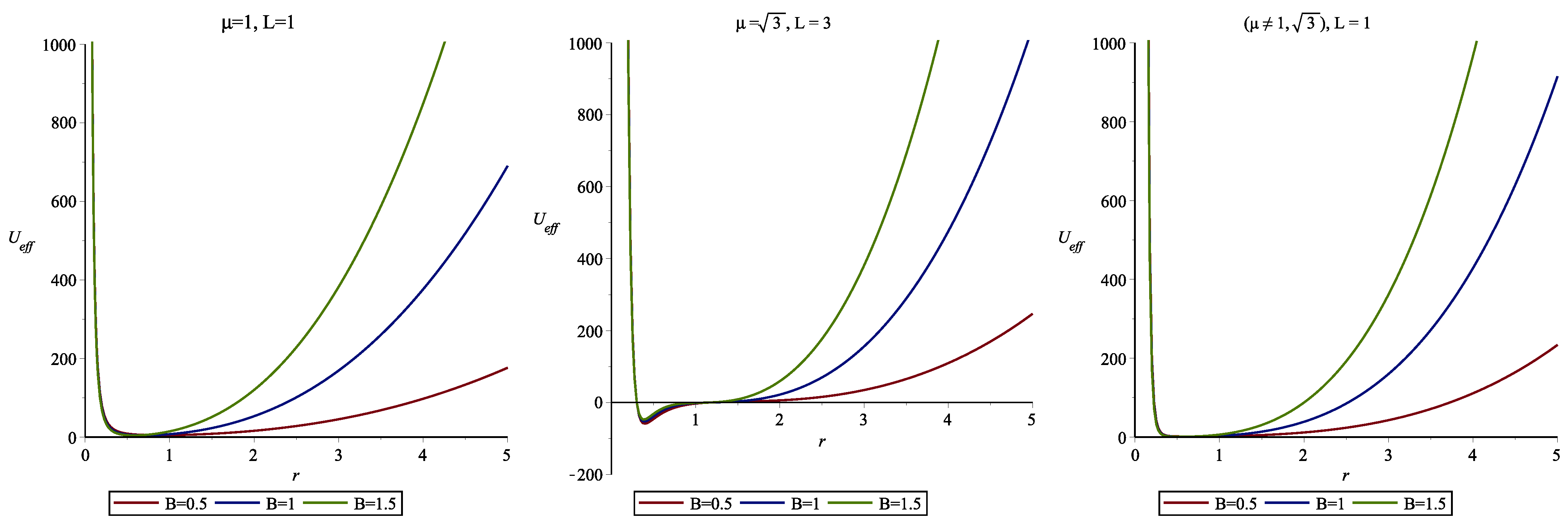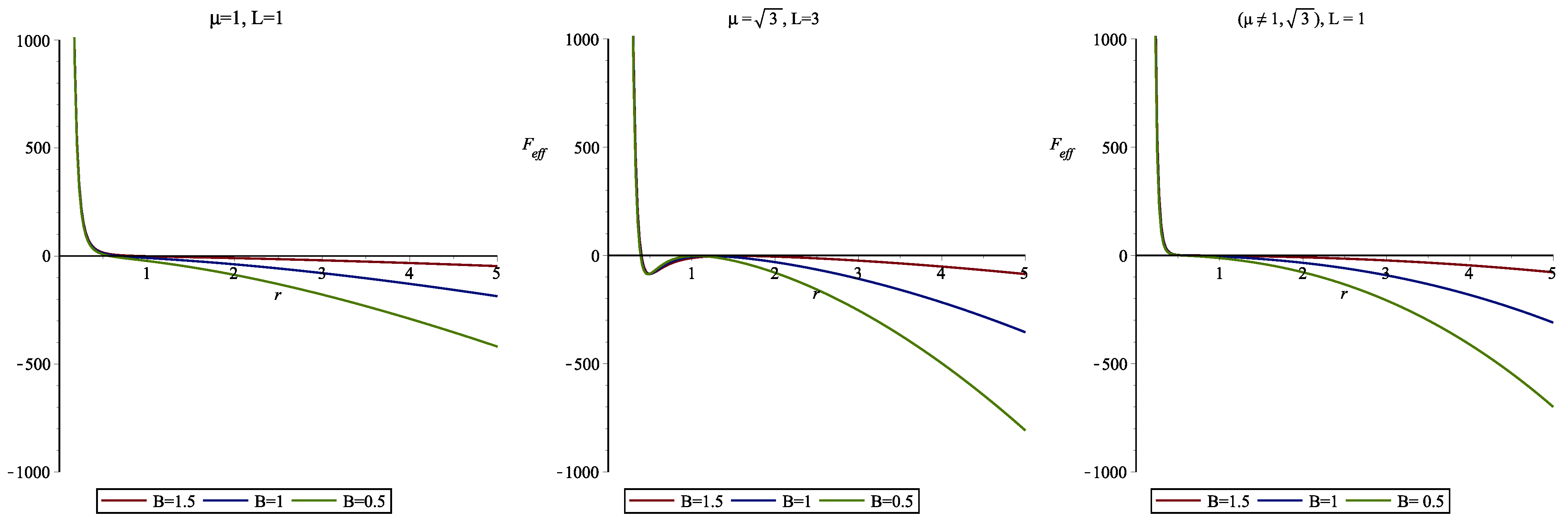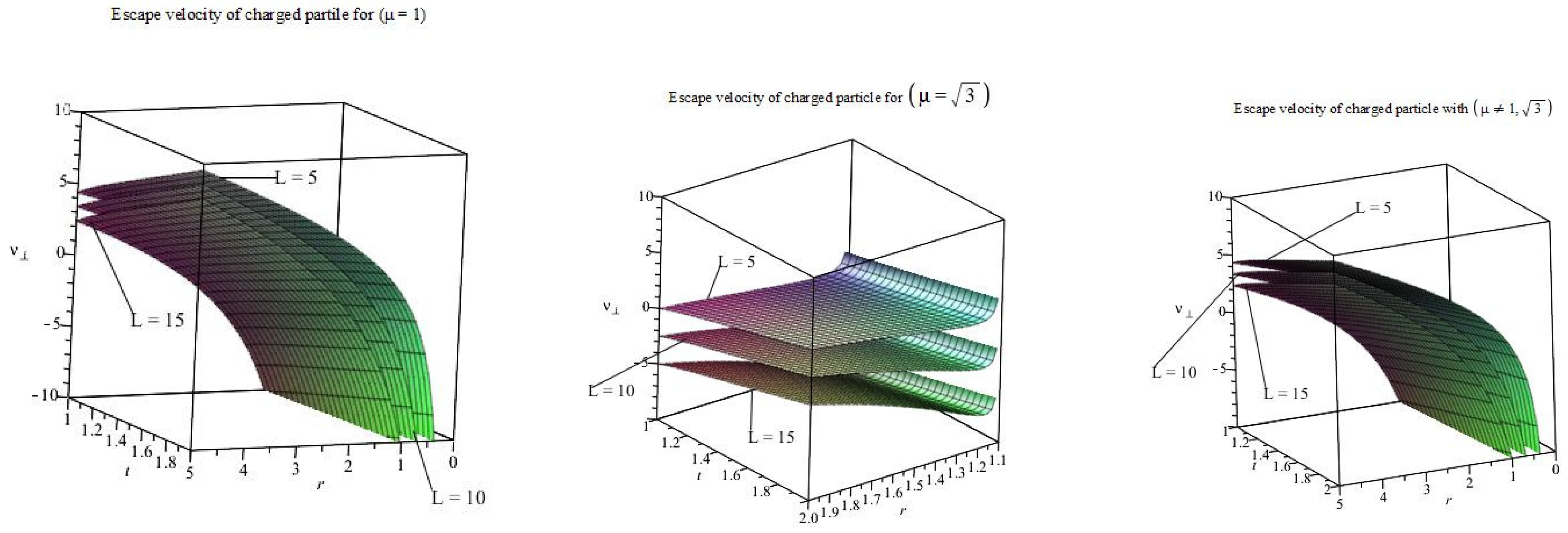Motion of Particles around Time Conformal Dilaton Black Holes
Abstract
1. Introduction
2. Conservation Laws
3. The Black-Hole Solution
Existence and Location of Horizon
4. Dynamics of the Neutral Particle
5. Dynamics of the Charged Particle
5.1. Behavior of the Effective Potential of the Charged Particle
5.2. Behavior of the Effective Force of the Charged Particle
5.3. Behavior of the of the Charged Particle
- For , near the singularity, the escape velocity is very low, as radial distance and time increases, the escape velocity increases which is evidence.
- For , the escape velocity is low for small radial distance, but it increases significantly as radial distance and time increases as compared to .
- Interestingly, for , it is observed that the escape velocity is very high near the BH, which provides the evidence that the Dilaton parameter is modeled by the dark energy. Hence, the particle is repelled due to the effect of dark energy, so the chances of escape are very high near the BH.
6. Conclusions
Author Contributions
Funding
Data Availability Statement
Conflicts of Interest
Nomenclature
| Symbol | Interpretation |
| Black hole | |
| Einstein field equation | |
| Schwarzschild black hole | |
| Reissner–Nordstrom black hole | |
| General relativity | |
| Approximate Noether symmetric | |
| Scalar field | |
| Maxwell inveriant | |
| Electromagnetic field | |
| R | Ricci scalar |
| Metric function | |
| Four dimension | |
| t | Time |
| r | Radial coordinate |
| First derivative w.r.t r | |
| Second derivative w.r.t r | |
| q | Electric charge |
| Angular momentum | |
| P | Power |
| Cosmological constant | |
| Effective potential | |
| Effective force | |
| Escape velocity | |
| B | Magnetic field |
| Dilaton parameter | |
| Electromagnetic potential | |
| Electromagnetic field tensor |
References
- Green, M.B.; Schwarz, J.H.; Witten, E. Superstring Theory: Volume 2, Loop Amplitudes, Anomalies and Phenomenology; Cambridge University Press: Cambridge, UK, 2012. [Google Scholar]
- Gibbons, G.W.; Maeda, K.-I. Black holes and membranes in higher-dimensional theories with dilaton fields. Nucl. Phys. B 1988, 298, 741–775. [Google Scholar] [CrossRef]
- Dehghani, M.; Setare, M.R. Dilaton black holes with power law electrodynamics. Phys. Rev. D 2019, 100, 044022. [Google Scholar] [CrossRef]
- Dehghani, M. Thermodynamics of (2 + 1)-dimensional black holes in Einstein-Maxwell-dilaton gravity. Phys. Rev. D 2017, 96, 044014. [Google Scholar] [CrossRef]
- Dehghani, M. Nonlinearly charged scalar-tensor black holes in (2 + 1) dimensions. Phys. Rev. D 2019, 99, 104036. [Google Scholar] [CrossRef]
- Bekenstein, J.D. Nonexistence of baryon number for black holes. II. Phys. Rev. D 1972, 5, 2403. [Google Scholar] [CrossRef]
- Teitelboim, C. Nonmeasurability of the quantum numbers of a black hole. Phys. Rev. D 1972, 5, 2941. [Google Scholar] [CrossRef]
- Sheykhi, A.; Kazemi, A. Higher dimensional dilaton black holes in the presence of exponential nonlinear electrodynamics. Phys. Rev. D 2014, 90, 044028. [Google Scholar] [CrossRef]
- Dehghani, M. Thermal fluctuations of AdS black holes in three-dimensional rainbow gravity. Phys. Lett. B 2019, 793, 234–239. [Google Scholar] [CrossRef]
- Sheykhi, A.; Naeimipour, F.; Zebarjad, S.M. Phase transition and thermodynamic geometry of topological dilaton black holes in gravitating logarithmic nonlinear electrodynamics. Phys. Rev. D 2015, 91, 124057. [Google Scholar] [CrossRef]
- Dehghani, M. Thermodynamics of (2 + 1)-dimensional charged black holes with power-law Maxwell field. Phys. Rev. D 2016, 94, 104071. [Google Scholar] [CrossRef]
- Kashif, A.K.; Seadawy, A.R.; Jhangeer, A. Numerical appraisal under the influence of the time dependent Maxwell fluid flow over a stretching sheet. Math. Methods Appl. Sci. 2021, 44, 5265–5279. [Google Scholar]
- Lu, D.; Seadawy, A.; Arshad, M. Bright-Dark optical soliton and dispersive elliptic function solutions of unstable nonlinear Schrodinger equation and its applications. Opt. Quantum Electron. 2018, 50, 23. [Google Scholar] [CrossRef]
- Dehghani, M.; Hamidi, S.F. Thermal stability analysis of nonlinearly charged asymptotic AdS black hole solutions. Phys. Rev. D 2017, 96, 044025. [Google Scholar] [CrossRef]
- Hendi, S.H. Asymptotically charged BTZ black holes in gravity’s rainbow. Gen. Relativ. Gravit. 2016, 48, 50. [Google Scholar] [CrossRef]
- Hendi, S.H.; Panahiyan, S.; Panah, B.E.; Momennia, M. Thermodynamic instability of nonlinearly charged black holes in gravity’s rainbow. Eur. Phys. J. C 2016, 76, 150. [Google Scholar] [CrossRef]
- Dehghani, M. Thermodynamic properties of dilaton black holes with nonlinear electrodynamics. Phys. Rev. D 2018, 98, 044008. [Google Scholar] [CrossRef]
- Seadawy, A.R.; Asghar, A.; Wafaa, A.A. Analytical wave solutions of the (2 + 1)-dimensional first integro-differential Kadomtsev-Petviashivili hierarchy equation by using modified mathematical methods. Results Phys. 2019, 15, 102775. [Google Scholar] [CrossRef]
- Frolov, V.P.; Novikov, I.D. Black Hole Physics, Basic Concepts and New Developments; Springer: Berlin, Germany, 1998. [Google Scholar]
- Sharp, N.A. Geodesics in black hole space-times. Gen. Relativ. Gravit. 1979, 10, 659–670. [Google Scholar] [CrossRef]
- Chandrasekhar, S.; Subrahmanyan, C. The Mathematical Theory of Black Holes; Oxford University Press: Oxford, UK, 1998; Volume 69. [Google Scholar]
- Borm, V.C.; Spaans, M. The influence of magnetic fields, turbulence, and UV radiation on the formation of supermassive black holes. Astron. Astrophys. 2013, 553, L9. [Google Scholar] [CrossRef][Green Version]
- Maqsood, F.; Yousaf, Z.; Bhatti, M.Z. Electromagnetic field and spherically symmetric dissipative fluid models. Pramana 2022, 96, 105. [Google Scholar] [CrossRef]
- Yousaf, Z.; Bhatti, M.Z.; Naseer, T. Evolution of the charged dynamical radiating spherical structures. Ann. Phys. 2020, 420, 168267. [Google Scholar] [CrossRef]
- Bhatti, M.Z.; Yousaf, Z. Dynamical instability of charged self-gravitating stars in modified gravity. Chin. J. Phys. 2021, 73, 115–135. [Google Scholar] [CrossRef]
- Bhatti, M.Z.; Yousaf, Z. Dynamical variables and evolution of the universe. Int. J. Mod. Phys. 2017, 26, 1750029. [Google Scholar] [CrossRef]
- Znajek, R. On being close to a black hole without falling in. Nature 1976, 262, 270–271. [Google Scholar] [CrossRef]
- Seadawy, A.R.; Iqbal, M. Propagation of the nonlinear damped Korteweg-de Vries equation in an unmagnetized collisional dusty plasma via analytical mathematical methods. Math. Methods Appl. Sci. 2021, 44, 737–748. [Google Scholar] [CrossRef]
- Blandford, R.D.; Znajek, R.L. Electromagnetic extraction of energy from Kerr black holes. Mon. Not. R. Astron. Soc. 1977, 179, 433–456. [Google Scholar] [CrossRef]
- Koide, S.; Shibata, K.; Kudoh, T.; Meier, D.L. Extraction of black hole rotational energy by a magnetic field and the formation of relativistic jets. Science 2002, 295, 1688–1691. [Google Scholar] [CrossRef] [PubMed]
- Frolov, V.P.; Shoom, A.A. Motion of charged particles near a weakly magnetized Schwarzschild black hole. Phys. Rev. D 2010, 82, 084034. [Google Scholar] [CrossRef]
- Pugliese, D.; Quevedo, H.; Ruffini, R. Motion of charged test particles in Reissner-Nordström spacetime. Phys. Rev. D 2011, 83, 104052. [Google Scholar] [CrossRef]
- Al Zahrani, A.M.; Frolov, V.P.; Andrey, A.S. Critical escape velocity for a charged particle moving around a weakly magnetized Schwarzschild black hole. Phys. Rev. D 2013, 87, 084043. [Google Scholar] [CrossRef]
- Shahzad, M.U.; Jawad, A.; Ali, F.; Abbas, G. Dynamics of particle near time conformal slowly rotating Kerr black hole. Chin. J. Phys. 2022, 77, 620–631. [Google Scholar] [CrossRef]
- Jawad, A.; Ali, F.; Shahzad, M.U.; Abbas, G. Dynamics of particles around time conformal Schwarzschild black hole. Eur. Phys. J. C 2016, 76, 586. [Google Scholar] [CrossRef]
- Khan, A.S.; Ali, F. The dynamics of particles around time conformal AdS-Schwarzschild black hole. Phys. Dark Universe 2019, 26, 100389. [Google Scholar] [CrossRef]
- Khan, I.A.; Khan, A.S.; Islam, S.; Ali, F. Particles dynamics around time conformal quintessential Schwarzschild black hole. Int. J. Mod. Phys. D 2020, 29, 2050095. [Google Scholar] [CrossRef]
- Jawad, A.; Umair Shahzad, M. Particle dynamics around time conformal regular black holes via Noether symmetries. Int. J. Mod. Phys. D 2017, 26, 1750059. [Google Scholar] [CrossRef]
- Farhad, A. Conservation laws of cylindrically symmetric vacuum solution of Einstein field equations. Appl. Math. Sci. 2014, 8, 4697–4702. [Google Scholar]
- Farhad, A.; Tooba, F.; Sajid, A. Complete classification of spherically symmetric static space-times via Noether symmetries. Theor. Math. Phys. 2015, 184, 973–985. [Google Scholar]
- Farhad, A. New black hole solutions of Einstein field equations and their Riemann curvature tensors. Mod. Phys. Lett. A 2015, 30, 1550028. [Google Scholar]
- Capozziello, S.; Man’ko, V.I.; Marmo, G.; Stornaiolo, C. Tomographic Representation of Minisuperspace Quantum Cosmology and Noether Symmetries (arXiv: 0706.3018 [gr-qc]) S. Capozziello, A. Stabile and A. Troisi. Class. Quantum. Grav. 2007, 24, 2153. [Google Scholar] [CrossRef]
- Capozziello, S.; Noemi, F.; Daniele, V. New spherically symmetric solutions in f (R)-gravity by Noether symmetries. Gen. Relativ. Gravit. 2012, 44, 1881–1891. [Google Scholar] [CrossRef]
- Paliathanasis, A.; Basilakos, S.; Saridakis, E.N.; Capozziello, S.; Atazadeh, K.; Darabi, F.; Tsamparlis, M. New Schwarzschild-like solutions in f (T) gravity through Noether symmetries. Phys. Rev. D 2014, 89, 104042. [Google Scholar] [CrossRef]
- Tsamparlis, M.; Paliathanasis, A. Lie and Noether symmetries of geodesic equations and collineations. Gen. Relativ. Gravit. 2010, 42, 2957–2980. [Google Scholar] [CrossRef]
- Dehghani, M. Thermodynamics of new black hole solutions in the EinsteinMaxwell-dilaton gravity. Int. J. Mod. Phys. D 2018, 27, 1850073. [Google Scholar] [CrossRef]
- Dehghani, M.; Hamidi, S.F. Nonlinearly charged black holes in the scalar-tensor modified gravity theory. Phys. Rev. D 2017, 96, 104017. [Google Scholar] [CrossRef]
- Zangeneh, M.K.; Dehghani, M.H.; Sheykhi, A. Thermodynamics of topological black holes in Brans-Dicke gravity with a power-law Maxwell field. Phys. Rev. D 2015, 92, 104035. [Google Scholar] [CrossRef]
- Dehghani, M. Thermodynamics of novel charged dilaton black holes in gravity’s rainbow. Phys. Lett. B 2018, 785, 274–283. [Google Scholar] [CrossRef]
- Dehghani, M. Thermodynamics of charged dilatonic BTZ black holes in rainbow gravity. Phys. Lett. B 2018, 777, 351–360. [Google Scholar] [CrossRef]
- D’Inverno, R.A. Introducing Einstein’s Relativity. Introducing Einstein’s Relativity by RA D’Inverno; Oxford University Press: New York, NY, USA, 1992. [Google Scholar]
- Aliev, A.N.; Gal’tsov, D.V. Magnetized black holes. Sov. Phys. Uspekhi 1989, 32, 75. [Google Scholar] [CrossRef]
- Moffat, J.W. Scalar–tensor–vector gravity theory. J. Cosmol. Astropart. Phys. 2006, 2006, 4. [Google Scholar] [CrossRef]
- Hussain, S.; Hussain, I.; Jamil, M. Dynamics of a charged particle around a slowly rotating Kerr black hole immersed in magnetic field. Eur. Phys. J. C 2014, 74, 3210. [Google Scholar] [CrossRef]











| Gen | First Integrals |
|---|---|
| Gen | First integrals |
|---|---|
Publisher’s Note: MDPI stays neutral with regard to jurisdictional claims in published maps and institutional affiliations. |
© 2022 by the authors. Licensee MDPI, Basel, Switzerland. This article is an open access article distributed under the terms and conditions of the Creative Commons Attribution (CC BY) license (https://creativecommons.org/licenses/by/4.0/).
Share and Cite
Shahzad, M.U.; Rehman, H.U.; Awan, A.U.; Tag-ElDin, E.M.; Rehman, A.U. Motion of Particles around Time Conformal Dilaton Black Holes. Symmetry 2022, 14, 2033. https://doi.org/10.3390/sym14102033
Shahzad MU, Rehman HU, Awan AU, Tag-ElDin EM, Rehman AU. Motion of Particles around Time Conformal Dilaton Black Holes. Symmetry. 2022; 14(10):2033. https://doi.org/10.3390/sym14102033
Chicago/Turabian StyleShahzad, Muhammad Umair, Hamood Ur Rehman, Aziz Ullah Awan, ElSayed M. Tag-ElDin, and Attiq Ur Rehman. 2022. "Motion of Particles around Time Conformal Dilaton Black Holes" Symmetry 14, no. 10: 2033. https://doi.org/10.3390/sym14102033
APA StyleShahzad, M. U., Rehman, H. U., Awan, A. U., Tag-ElDin, E. M., & Rehman, A. U. (2022). Motion of Particles around Time Conformal Dilaton Black Holes. Symmetry, 14(10), 2033. https://doi.org/10.3390/sym14102033






